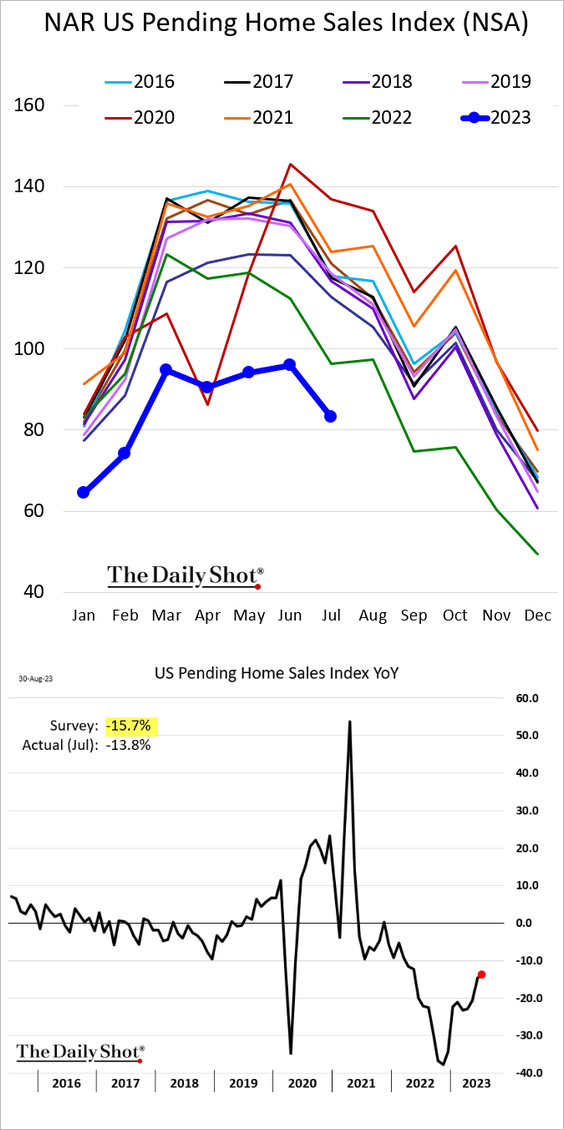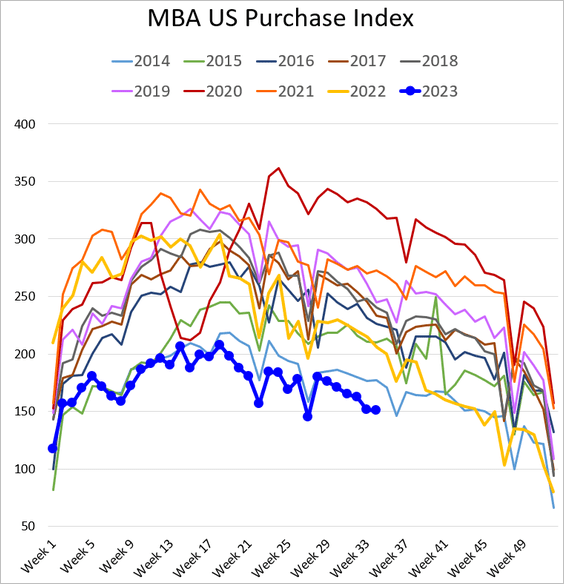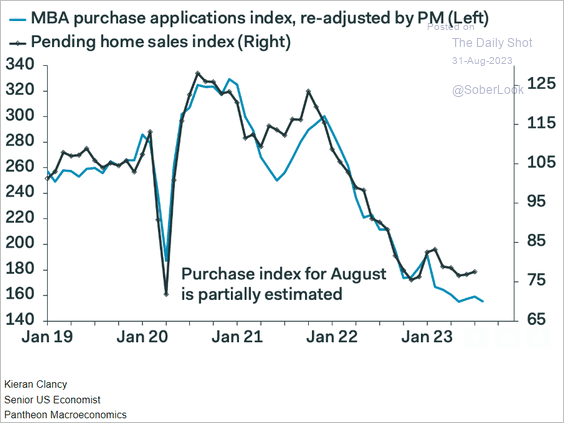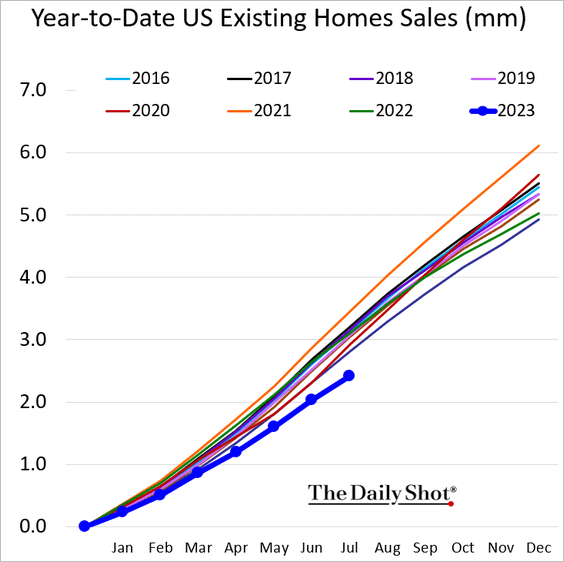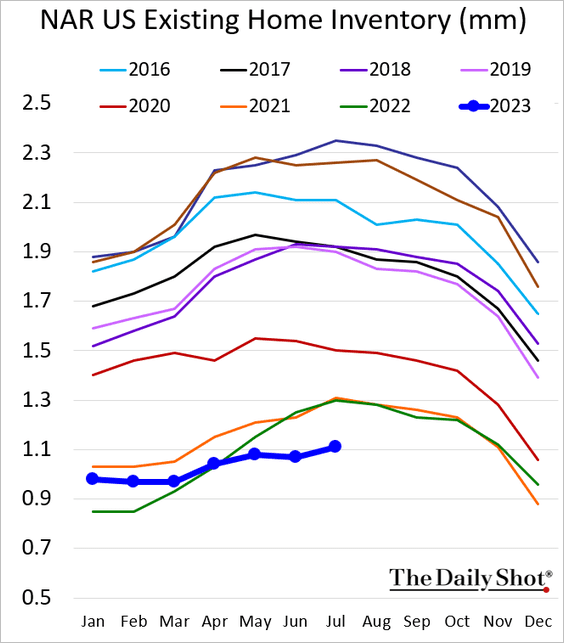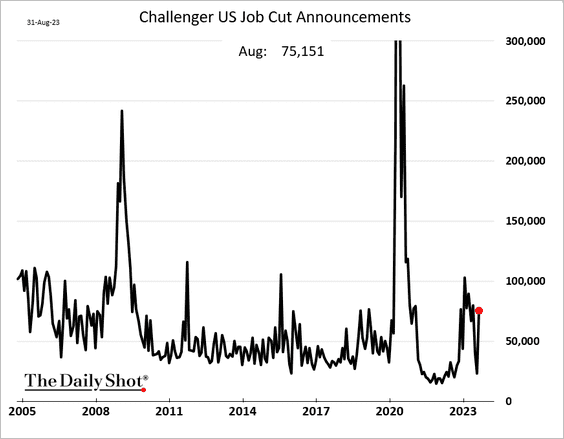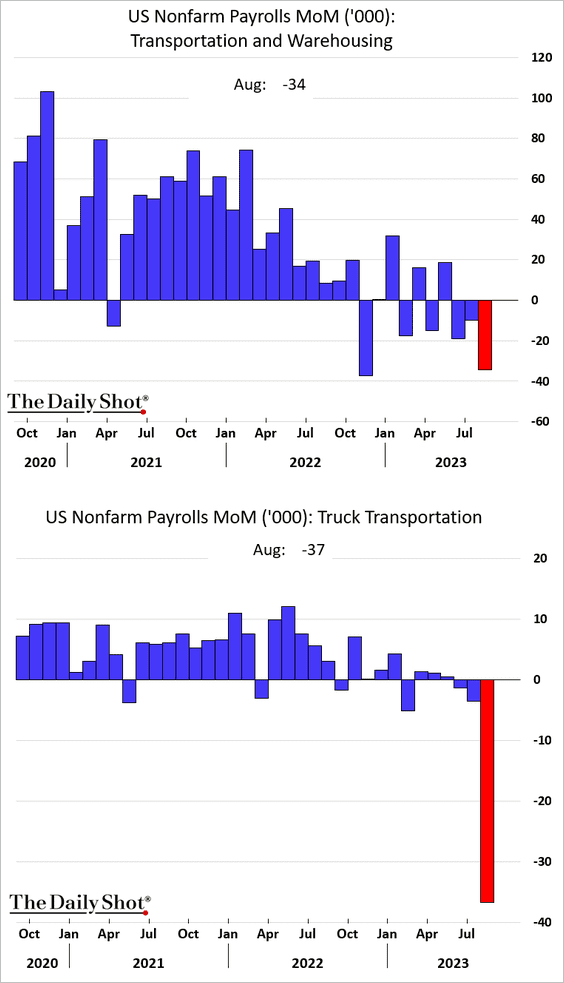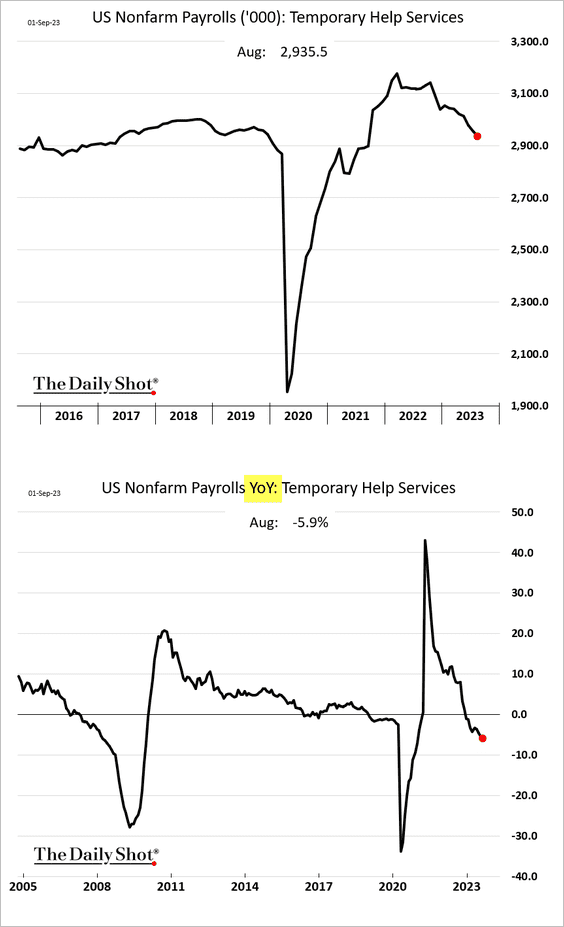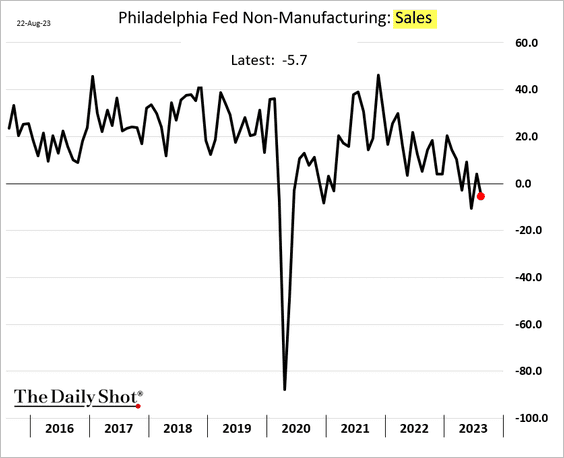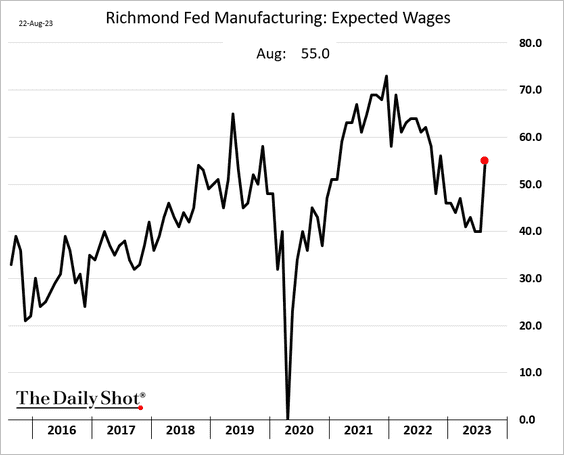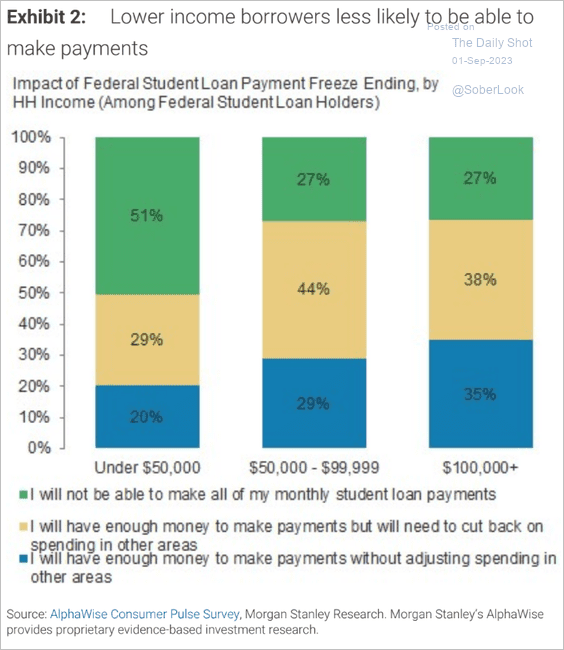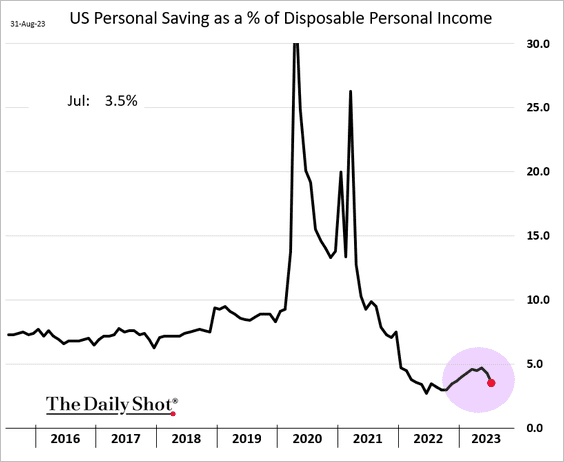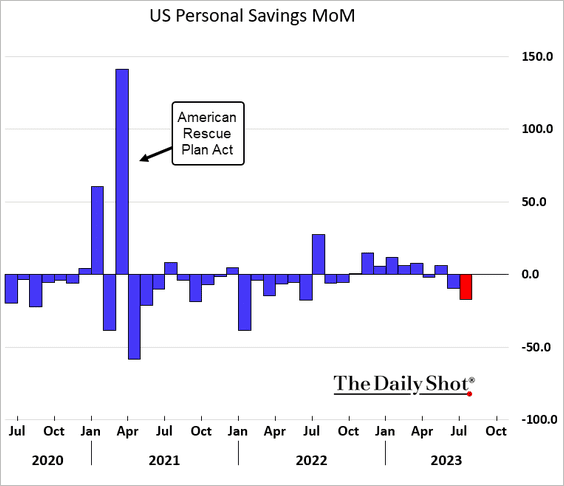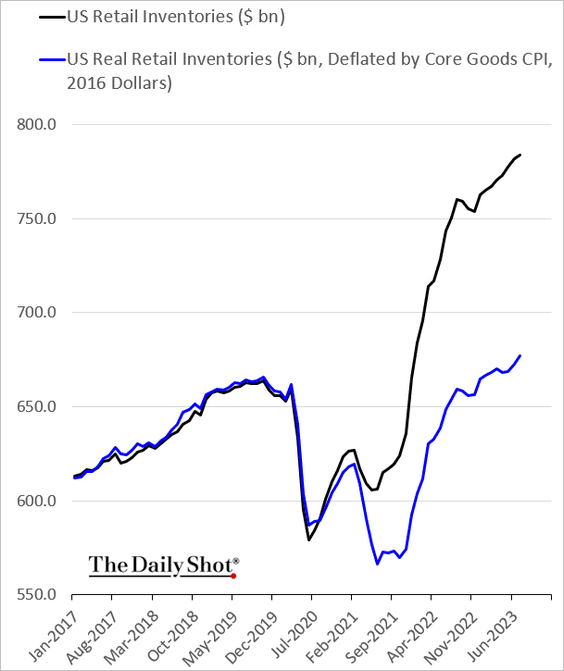Good morning and happy Monday! We remember those whose lives were lost 22 years ago today in the horrific September 11 terrorist attacks. World relations were reset that day and the effects still resonate.
Keeping up with global economic data is a monumental task. With a financial planning and investment management firm to run, that is committed to doing our own independent research, we are forever grateful to the many excellent Economic aggregation resources that take the work out of gathering this data for us each day. They don’t give us analysis – that’s our job – but just compiling this information can be a full-time job. We want to give a big shout-out (and a thank you) to MacroMicro, TradingEconomics, and The Daily Shot. Though we use several more, these are three of our favorite places to see a daily aggregation of economic data, and you’ll often see their charts used here.
- Housing Update
- Jobs update
- Manufacturers show prices are rising again
- GDP and GDI estimates have diverged
- Consumer Update
Housing Update
The 30-year mortgage rate continues to climb, which is continuing to batter the mortgage and housing markets. We believe this trend will continue. Current pending home sales deteriorated in August in a typically seasonal fashion, albeit with the lowest number of sales in the last decade:
Actual closed home sales in August are way off from the trend over the last decade:
Because home sales tend to be seasonal, it’s important to see how this July looks compared to an average July. As you can see, we have had 7 consecutive months of home sales that have been 6% -15% below their monthly average, and the trend continues to worsen:
We don’t see reason for optimism in the near future, either, as mortgage applications typically lock about 30 days ahead of the home closing date. In this case, the drop in mortgage applications declined, but at a more moderate clip. This is easily the slowest mortgage lending market since the Great Recession:
Here is another look at the connection between mortgage applications and pending home sales. Whenever mortgages drop, housing sales follow in short order. There is some discrepancy between these numbers because refinances do not create a home sale, so times of high refinance activity will pull away from the home sales line.
The total YTD home sales in the U.S. is at a 10-year low and the gap between a “normal” trend and this year is widening as we head into the last part of the year:
The only thing keeping prices up at this point is the total lack of inventory. Because 75% of all home loans are at 5% or lower interest rates, there is little incentive to sell a house (even at these inflated prices) because the seller cannot replace the good rate and terms on their current mortgage. We very much do expect to see house prices come down 15% or more over the next two or so years (more in specific markets), but it will be, unfortunately, the loss of rental properties and homes due to the economic slowdown that will cause most of it. As rates drop later in the Fed’s policy cycle, you may also see a glut of inventory return to the market, which should lower prices a little further.
That lack of inventory, as I mentioned above, is the only thing holding up home prices so far:
What this means for you
Housing is being heralded by many market analysts (and the real estate industry writ large) of a sign of resiliency. We believe nothing could be further from the truth. I believe we are headed for a significant housing market decline in the coming months. Clients who are interested in buying a home or a second home may very well have the opportunity to do so at dramatically better prices in the next 18-24 months, but other clients who are interested in selling property may have a long time to wait for those home prices to return. Our macro models are not invested in either real estate or mortgage/property finance at this time.
Jobs Updates
We look at jobs regularly, and the current trajectory remains unchanged. Initial claims, while still low, are trending higher, and continuing claims remain my most persistent worry. This week’s initial jobless claims came in slightly below expectations, though trending against historical trends. This week, we have a couple of other significant bits of data that sheds better light on where we’re headed.
First, initial claims for unemployment were lower these past two weeks but I am leery about the accuracy of the data, because ever time we saw a significant drop in initial claims this summer, it was due to one state removing a huge number of claims at once, claiming it was removing “fraudulent” claims. To remove them from INITIAL filings instead of continuing filings doesn’t make sense to me. Did hundreds of thousands of fraud cases show up in the same week? No, or we would have seen major spikes in initial claims which we have not seen.
Initial jobless claims trended down in a pretty typical seasonal pattern, but this number has been so wildly revised in later weeks that it’s hard to give a lot of credence to the first print. Much more accuracy tends to follow in the later revisions. As of now, however, it looks like workers did not file for too many first-time unemployment claims the last two weeks:
However, the number we have told our clients and readers for months to pay much more attention to are the continuing claims. In a strong economy, there are always some layoffs happening, but it is usually very easy to find another job if this unfortunate event happens to you. In this case, continuing claims, which started off 2023 at the lowest rate in a decade, have slowly climbed into the middle of the pack, and continue to buck against trends. The fact that continuing claims remain persistently high tells us that it is becoming increasingly difficult to find a new job if you lose one.
The weekly trend for 2023 (comparing the average of the last three “normal” hiring years) shows clearly that layoffs, once they happen, are much more lasting events in a person’s finances than they used to, and the trend is slowly getting worse:
Additionally, after a sharp drop in layoff announcements earlier this year, the number of companies that have announced layoffs spiked sharply last month. If you ignore the chaos of the Covid pandemic, it is very rare to see layoff announcements this high in the last 15 years.
It’s also interesting to see where jobs are being gained and lost. Layoffs in manufacturing, which has been happening all year, increased sharply in August, but the real surprise came in transportation and shipping (second chart). This makes sense from an economic point of view, because we had seen retail inventories shrink due to stores not purchasing at the same levels from their wholesalers, and the inventory levels at those wholesalers were climbing sharply all summer.
Of note also is the significant drop in the hiring of temporary workers. This has been going on for the last 18 months, but the drop in temp worker hiring is accelerating:
What this means to you
The job market is usually the last place to show a recession. There is usually a gradual slowdown, followed by a sudden, surprise, major uptick in layoffs all at once as the recession’s impact is finally felt. While employment remains relatively strong right now, it is showing much more obvious signs of strain. Sadly this will get worse as we head into a recession – that’s an economic certainty and one the Federal Reserve is actually trying to achieve without too many job losses. We urge our clients to reduce their debt load and increase their personal savings, and keep investments conservatively positioned for now. A recession doesn’t mean the end of the world, but it does mean seeing our unemployment rate climb from its current 3.5% to maybe 5.5% or 6.5%. That means, sadly, a lot of lost jobs and financial hardship for many families, so please take the risk of job insecurity seriously.
Manufacturers report inflation is rising again.
Just as we highlighted in our last nSight report two weeks ago, the manufacturing sector continues to report slower output, but the concerning part is that both current and expected prices are climbing sharply again. Now more Fed sectors have reported in, confirming the same price spikes as we showed you two weeks ago.
First, the Philly Fed shows sales slowed but prices (both paid out to their own suppliers and what they expect to charge customers) spiked sharply last month:
The Richmond, VA Fed district reported a similar spike in prices, including a dramatically higher spike in expected wages:
The economic condition where you have declining (or stagnant) productive output, combined with increasing prices is called STAGFLATION. It can be argued that stagflation is the worst of all economic conditions. It may be too early yet to determine of inflation truly is returning for another ugly rise, but if it is, it is happening even though demand for products and services is slowing down. This would be the definition of a stagflationary environment.
What this means for you
We are 100% certain that a recession is imminent. We’ve said this for many months now. We believe we are on the cusp now, and as the data bits below regarding consumer financial health will indicate, we are very likely about to see significant reversals in several of the investment markets. Our clients remain very conservatively invested in our defensive, macroeconomic data-dependent models, and we are watching for opportunities to improve safety and increase yields on a weekly basis.
GDP and GDI have diverged – which one is correct?
There are several measures of economic output in the United States, the most commonly referenced being the GDP report (gross domestic product). But there is another – GDI – gross domestic income, that typically runs in lock-step with GDP and has diverged only slightly over the last several years, as you can see below. The divergence between GDP and GDI today, however, is dramatic and in terms of recent history, unprecedented:
Why does this matter? It raises the question of which trajectory for the economy is correct. As we can see in the graph below, in the graph to the left, we see the reported GDP number in black, and the GDI number in red. While they were close until the third quarter of 2023 (exactly a year ago), they suddenly diverged in a meaningful way, and one economists must take serious note of.
GDP has been reported to be strong (2-ish % growth each quarter for a year), but GDI is showing a recession may have actually started a year ago. And while GDI is trending better, GDP is worsening.
In the graph on the right, we can see that there has never been as sharp of a difference between GDP and GDI in more than 75 years:
What this means to you
One of these two numbers is either wrong, or GDI is leading GDP by as much as 9-12 months, and we may see a recession declared by Q4 of this year. I actually believe we will see a recession declared as having started in Q2 of 2023 once history looks back at this time period (recessions are always at least 6 months underway before they are officially declared, and some recessions have fully recovered before they are finally confirmed by the data).
What this means, though, is there is NOT good data on the state of the economy and this is why you can find optimism in some analysts and extreme pessimism in others. We remain data-dependent, however, and the overwhelming bulk of economic data points to not only a recession being imminent, but it may be a potentially serious one. We maintain very defensive positions for most of the accounts we manage for our clients.
Consumer Update
Finally, we have a smattering of diverse “hints” around consumer spending and bank credit to give us a better picture of where we are headed. Remember that 70% of our entire economy depends on private consumption – that is, you and I spending our paychecks. If the consumer is not in a place able to buy products and services, because of job insecurity, high taxes, or inflation, the economy will suffer.
The first graph explores the changes in consumption from this year to next year. As we’ve mentioned several times already, it is expected that student loans returning this month will have a substantial drag on the economy that was not there prior:
Speaking of student loans, consumers are reporting that the return of this payment will be difficult if not impossible to absorb into a family budget, depending on the household income. Fully 51% of people earning less than $50,000 annually report not being able to pay all of their student loan payments, with another 29% saying it will seriously impact other spending. That number actually increases in the higher income ranges, in which case 44% of people earning $50,000-$100,000 and 38% of people making more than $100,000 say the student loan payments will cause them to spend less in other places. This one factor is what we believe will take us from an economy barely hanging on, into a full-fledged recession in short order.
This comes as consumers also report that all of the excess savings from the Covid-19 stimulus have finally evaporated (multiple charts):
The slowing of spending has been happening for a while, but we believe that will get much worse shortly. This graph shows the inventory levels of U.S. retailers over the last many years. The black line is massive, but that is because it shows the value of the retail inventory using currently inflated high prices. The blue line is a more accurate look at the inventory levels at retailers, and as you can see, retail inventories are climbing quickly. Because we know that most retailers have slowed their purchases and trucking has suffered a massive slowdown, this rise in inventory levels is NOT related to purchases stores are making, bur rather they are because stores are seeing fewer customers and lower sales. The inventory is stacking up on the retailers, who have, in turn, slowed their purchases from their suppliers.
Indeed, China reported in July that their exports were down almost 15% from the year before.
What this means for you
Despite statements to the contrary from various market pundits, we see a significant slowdown in consumer spending well underway already, and that will only get worse as student loans return this month. The slow-down can be seen at every point in the supply chain, all the way back to U.S. manufacturers and overseas exporters. We firmly believe a recession is already here, but will not be officially acknowledged for at least 3 more months. We remain conservatively invested and allow the economy to direct our decisions, not market sentiment and herd bias. The data clearly shows, from nearly every angle we can find, a deteriorating economic environment, and our clients are correctly positioned for protection against, and even the possibility to gain from, the coming downturn.
Bottom Line:
We remain convinced that a recession is imminent, even as the market fights back hard against it. Do not let the current market rally fool you – there is no sustainable way to grow profits (and therefore a supportable stock price) in an economy that is rapidly losing steam. Corporate profit reports are backward-looking and economic projections are forward-looking. Do not be lulled into complacency just because the stock market allows itself to.
We’ve been alerting our clients for nearly two years now that inflation was going to cause significant problems and our central banks would have to take progressively stronger actions to combat it. That appears to be a correct call.
No one knows exactly when a recession will be declared, but we firmly believe most of the larger economies of the world are right at the door of one now. Recessions can take years to recover from, which is why we believe it is vitally important to get your family and business finances ready to weather through such a storm.
We predicted the beginning of a turn in the current market rally last week, and we reiterate that sentiment now. There will always be market movement that runs counter to the economic data because markets are much more short-term focused, and let’s face it: until fear takes hold, greed is the prevailing emotional state of most market participants. We do believe, however, that the recent rally has fully run its course, and there will soon be a strong shift from stocks into safer investment options such as corporate and government bonds. With interest rates this high, getting a 5% or better yield, risk-free is becoming a more and more attractive option for investors concerned about the coming economic uncertainty. Once there is consensus that either the economy is earnestly deteriorating, or the Fed announces the end of rate hikes, the move from stocks to bonds will accelerate.
Whether you are our client or not, you need to consider the broader economy (and much less so the daily market fluctuations) when making investment decisions. The economy is telling us clearly what is coming, and you need to have your investment accounts prepared before that happens.
Just this past spring, I published an ebook to help you get your finances ready for the recession directly ahead. It’s yours totally free. Just click on the book image to access and download it.
Use these economic reports, and those of others working in this space, to prepare. You can not only avoid much of the pain that is coming, but you might actually profit from it, if your investments are properly positioned, and you’ve done what you can to shore up your business’ and family’s financial situation. If you need help with this, nVest Advisors has amazingly affordable personal financial planning and fiduciary investment management services to help you.
This is what we do for a living, and we’re very happy to partner with you on that endeavor.
Reach out to us for a totally free financial and portfolio checkup today if you’re concerned about where your finances sit for the coming few years, particularly if you are at or approaching retirement age. We’re delighted to offer you our thoughts. You can schedule that time with us below:
Watching This Week:
- Jobs Report
- Service Sector Update
- Commodities
